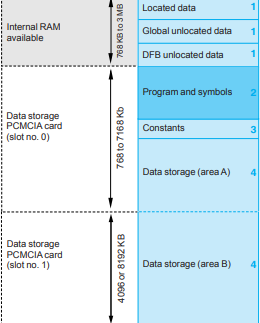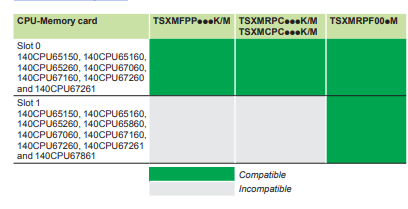
schneiderModicon Quantum automation platform
addressing removes the memory “mapping” management constraints because
the addresses are assigned automatically.
v DFB unlocated data corresponding to DFB user function blocks. The size of this
object area is only limited by the size of the internal RAM physical memory
available.
2 Application program and symbols area in the internal RAM or in the PCMCIA
memory card (descriptor, executable code for the tasks and application symbols
database)
3 Constants area in internal RAM or the PCMCIA memory card (constant words,
initial values and configuration)
4 Area for storing additional data that can be used for distributed applications to
store information such as production data and manufacturing recipes (only on
140CPU65150, 140CPU65160, 140CPU65260, 140CPU65860, 140CPU67060,
140CPU67160, 140CPU67260, 140CPU67261 and 140CPU67861 CPUs)
According to the application memory size requirements, two memory structures are
possible depending on whether the Quantum CPU has 0, 1 or 2 PCMCIA memory
expansion cards:
b Application in internal RAM, the application is completely loaded into the CPU’s
battery-backed internal RAM (2) the capacity of which depends on the CPU model.
b Application in the PCMCIA card, the internal RAM is reserved for the application
data. The PCMCIA memory card contains the program space (program, symbols
and constants areas). Certain types of PCMCIA memory card also take the data
storage area.
The presence of the symbols area with the program area is optional. The fact of
having the application symbols database on the PLC means that, when it is
connected to an empty programming PC (with no applications), all the elements
needed to debug or upgrade this PLC are available
Memory structure (continued)
Modicon Quantum automation
platform
Unity Pro standard CPUs
CPU with 2 PCMCIA memory cards in slot no. 0 and no. 1

Memory structure (continued)
Expansion of the file storage area
With the TSXMRPF004M, TSXMRPF008M file storage memory cards (4096 or
8192 KB):
b A file storage area can be provided when the application is completely loaded in
the internal RAM
b Memory space can be freed up for the program when the application is in the
PCMCIA card
The Unity Pro programming software assists the application designer with
management of the structure and the occupation of memory space in the
Quantum PLC.

Protecting the application
Whether located in the internal RAM or in the PCMCIA card, the application can be
protected with a key switch (see page 1/8 and page 1/9), in order to prohibit access
to it
(read or modify program) online in Unity Pro.
Modicon Quantum automation
platform
PCMCIA memory expansion cards
Unity Pro
Presentation
PCMCIA memory expansion cards make it possible to expand the RAM memory
capacity of high-performance Quantum CPUs.
Depending on the model, these cards are designed to accommodate:
b The application program, symbols and constants
b The additional application data
b Or both
PCMCIA memory expansion cards
These cards provide three different storage types:
b Storage of the application: Program, symbols, and constants in a common space
of 512 KB to 4096 KB: TSXMFPPpppK/M for Flash EPROM memories
b Storage of the application and additional data, comprising:
v An application area of 192 KB to 7 MB
v A data storage area of up to 7 MB for additional data
The limit between these two spaces is configurable. The configurable cards are:
v TSXMRPCpppK/M for SRAM memories
v TSX MCPCpppK/M for Flash EPROM and SRAM memories
b Storage of additional data, provided by SRAM TSXMRPF004M, TSXMRPF008M
4 or 8 MB memory cards

These cards use two technologies:
b Battery-backed SRAM
Used particularly in the application program design and debugging phases.
These cards provide:
v All of the application's transfer and modification services in online mode
v Additional data storage
The memory is protected by a removable battery built into the PCMCIA card.
A second auxiliary battery is present to enable the main battery to be replaced
without loss of data.
b Flash EPROM
Used when debugging of the application program is complete. This is used to:
v Overcome battery life restrictions
v Perform one global application transfer
When in use, it is impossible to carry out modifications to the application in online
mode.
Program modification in online mode
Only those expansion cards in which the program is stored in SRAM memory
TSXMRPCpppK/M allow program modifications to be carried out in online mode.
A user with a CPU equipped with a memory expansion card and who wishes to make
modifications or additions to the program in online mode must structure the
application program in several reasonably sized sections.
Modicon Quantum automation
platform
Racks

Description
Five different rack models are available, with 3, 4, 6, 10 or 16 slots. The rack slots
are universal (any module can fit into any slot). Almost all Quantum modules are
designed to fit into a single slot in a Quantum rack (1).




























































































































